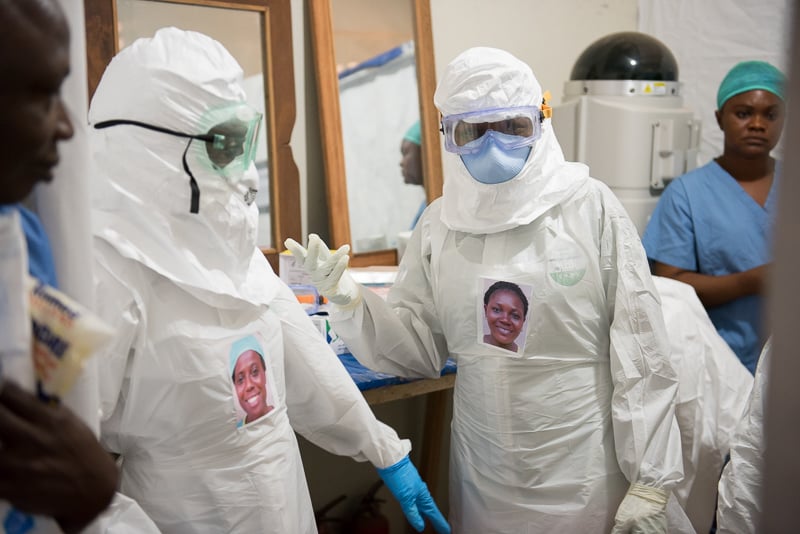
For patients suffering from Ebola, the necessity of the intimidating-looking protective suits used by health care workers can mean going for days without seeing a human face. Los Angeles artist Mary Beth Heffernan saw this as a problem with an obvious solution: applying a sticker with a photograph of the doctor or nurse’s smiling face to the exterior of the suit, to show the patient who was taking care of them.
With the Ebola epidemic raging through West Africa last year (see Artist Captures the Face of Ebola in Photography Project, In Ebola Hot Zone, Art Exhibition Offers Hope, and Italian Land Art Spreads Ebola Awareness), Heffernan was struck by images of patients being treated by doctors in the hazmat-like PPE suits. “They looked completely menacing,” she told NPR. “They really made people look almost like Stormtroopers. I imagined what would it be like to be a patient? To not see a person’s face for days on end?”
It was clear to her that such depersonalized interactions were making a traumatizing experience even worse, and that outfitting the suits with a humanizing photograph would be incredibly easy. “It’s not a sophisticated response,” she added. “It’s almost stupidly simple.”
As Heffernan, an art professor at Los Angeles’s Occidental College, prepared for an upcoming teaching sabbatical, she decided to commit the $5,000 in grant money she had received for work on an art project to developing a photo kit to be used in West African hospitals fighting the deadly disease.
Though the PPE Portrait Project may not seem like art, Heffernan insists that “this is in the spirit of social sculpture. This is part of that history of making art that’s about action, about changing society.”
Her biggest challenge was perhaps connecting with West African health workers. After reaching out unsuccessfully to 75 different contacts, she finally got the go ahead on the project from Liberia’s Ebola case manager, Moses Massaquoi.
After months of testing at home, Heffernan flew to Liberia with 12 large boxes of supplies. There was more trial and error on the ground, but after some initial misfires with the portable printer cables, Heffernan was able to print stickers of smiling health care workers that could easily be applied to the chest of their PPEs.
So far, the project has worked well—although the stickers were perhaps too big a hit among the workers, for whom printed photos remain somewhat of a novelty. One man even plastered his car with the images of his face. Heffernan plans to bring photo paper on her next trip, which will be to Sierra Leone, so that workers can have a copy to take home.
“I feel like I’m working now with other human beings instead of, I almost want to say, like white monsters or white zombies or something,” a satisfied Jennifer Giovanni, the head of infection control at a Liberian treatment center, told NPR.